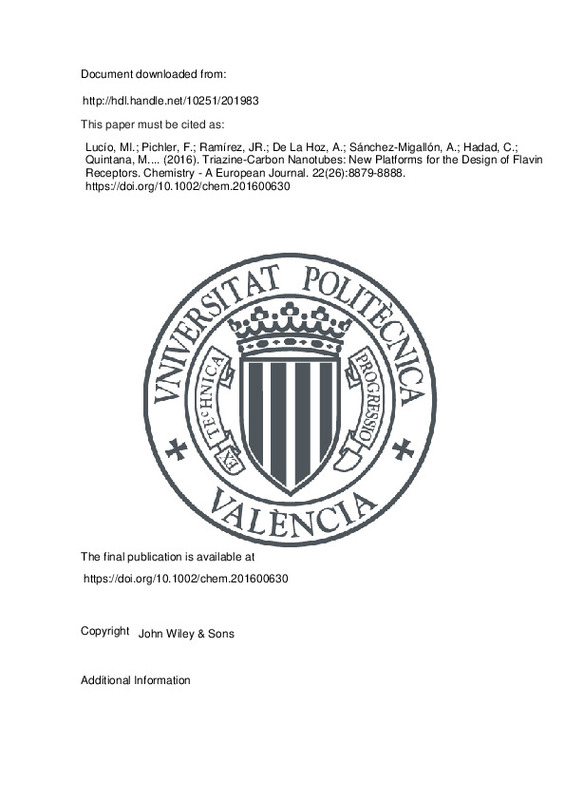Lucío, MI.; Pichler, F.; Ramírez, JR.; De La Hoz, A.; Sánchez-Migallón, A.; Hadad, C.; Quintana, M.... (2016). Triazine-Carbon Nanotubes: New Platforms for the Design of Flavin Receptors. Chemistry - A European Journal. 22(26):8879-8888. https://doi.org/10.1002/chem.201600630
Por favor, use este identificador para citar o enlazar este ítem: http://hdl.handle.net/10251/201983
|
Título:
|
Triazine-Carbon Nanotubes: New Platforms for the Design of Flavin Receptors
|
|
Autor:
|

 Lucío, María Isabel
Pichler, Federica
Ramírez, José Ramón
De la Hoz, Antonio
Sánchez-Migallón, Ana
Hadad, Caroline
Quintana, Mildred
Giuliani, Angela
Bracamonte, María Victoria
Fierro, Jose L. G.
Tavagnaco, Claudio
Herrero, Maria Antonia
Prato, Maurizio
Vázquez, Ester
Lucío, María Isabel
Pichler, Federica
Ramírez, José Ramón
De la Hoz, Antonio
Sánchez-Migallón, Ana
Hadad, Caroline
Quintana, Mildred
Giuliani, Angela
Bracamonte, María Victoria
Fierro, Jose L. G.
Tavagnaco, Claudio
Herrero, Maria Antonia
Prato, Maurizio
Vázquez, Ester
|
|
Entidad UPV:
|
Universitat Politècnica de València. Escuela Técnica Superior de Ingeniería Agronómica y del Medio Natural - Escola Tècnica Superior d'Enginyeria Agronòmica i del Medi Natural
|
|
Fecha difusión:
|
|
|
Resumen:
|
[EN] The synthesis of functionalised carbon nanotubes as receptors for riboflavin (RBF) is reported. Carbon nanotubes, both single-walled and multi-walled, have been functionalised with 1,3,5-triazines and p-tolyl chains ...[+]
[EN] The synthesis of functionalised carbon nanotubes as receptors for riboflavin (RBF) is reported. Carbon nanotubes, both single-walled and multi-walled, have been functionalised with 1,3,5-triazines and p-tolyl chains by aryl radical addition under microwave irradiation and the derivatives have been fully characterised by using a range of techniques. The interactions between riboflavin and the hybrids were analysed by using fluorescence and UV/Vis spectroscopic techniques. The results show that the attached functional groups minimise the p-p stacking interactions be-tween riboflavin and the nanotube walls. Comparison of p-tolyl groups with the triazine groups shows that the latter have stronger interactions with riboflavin because of the presence of hydrogen bonds. Moreover, the triazine derivatives follow the Stern-Volmer relationship and show a high association constant with riboflavin. In this way, artificial receptors in catalytic processes could be designed through specific control of the interaction between functionalised carbon nanotubes and riboflavin.
[-]
|
|
Palabras clave:
|
Donor-acceptor systems
,
Molecular recognition
,
Nanotubes
,
Noncovalent interactions
,
Receptors
|
|
Derechos de uso:
|
Reserva de todos los derechos
|
|
Fuente:
|
Chemistry - A European Journal. (issn:
0947-6539
)
|
|
DOI:
|
10.1002/chem.201600630
|
|
Editorial:
|
John Wiley & Sons
|
|
Versión del editor:
|
https://doi.org/10.1002/chem.201600630
|
|
Código del Proyecto:
|
info:eu-repo/grantAgreement/MICINN//CTQ2011-22410/ES/TECNOLOGIAS EMERGENTES. DESARROLLO DE NUEVAS METODOLOGIAS Y APLICACIONES EN QUIMICA DE MATERIALES Y SUPRAMOLECULAR/
info:eu-repo/grantAgreement/MINECO//CTQ2014-53600-R/ES/MATERIALES BASADOS EN GRAFENO COMO SISTEMAS PROGRAMABLES MULTI-ESTIMULO-RESPUESTA PARA LA LIBERACION CONTROLADA DE FARMACOS/
info:eu-repo/grantAgreement/EC//PEII-2014-002A/
info:eu-repo/grantAgreement/MIUR//2010N3T9M4/
info:eu-repo/grantAgreement/MIUR//Firb RBAP11ET-KA/
|
|
Agradecimientos:
|
M.V.B. undertook this work with the support of the "ICTP TRIL Programme, Trieste, Italy". Financial support from the Spanish MINECO (projects CTQ2011-22410 and CTQ2014-53600-R), the FEDER Project PEII-2014-002A, the ...[+]
M.V.B. undertook this work with the support of the "ICTP TRIL Programme, Trieste, Italy". Financial support from the Spanish MINECO (projects CTQ2011-22410 and CTQ2014-53600-R), the FEDER Project PEII-2014-002A, the University of Castilla-la Mancha, the University of Trieste and the Italian Ministry of Education MIUR (cofin Prot. 2010N3T9M4 and Firb RBAP11ET-KA) is gratefully acknowledged. We also thank Dr. Emilio M. Perez for help with Raman spectroscopy.
[-]
|
|
Tipo:
|
Artículo
|







![[Cerrado]](/themes/UPV/images/candado.png)


